Scientists used a year’s worth of data from eastern China to analyze which weather conditions influence abnormal, high and low PV production days. They also constructed a simple prediction model for extreme output and examined the atmospheric circulation anomalies corresponding to extreme output events.
Researchers from the China Electric Power Research Institute have outlined a new classification of weather types based on abnormal PV yield events and different weather types. Based on this new taxonomy, they developed a simple model for predicting extreme returns.
“Currently, our model is based on the East China region as an example, but we believe the model has the potential to be applied to other regions,” said the corresponding author. Fan Yang, told pv magazine. “The model essentially finds the weather processes associated with abnormal output and attempts to use them as a basis for predicting future abnormal output events. Therefore, we estimate that in different regions, the types of weather associated with abnormal output events may differ from those in the paper.
The analysis was based on output data from 76 distributed PV power plants in eastern China, coupled with meteorological data from the European Center for Medium-Range Weather Forecast, Fifth Generation Reanalysis dataset. The data for the entire year 2022 was used for clustering, while data from January 1, 2023 to March 31, 2023 was used for validation.
“Extremely high or low photovoltaic output events can result in significant electricity waste or shortages, placing high demands on energy storage and backup power configurations, and even potentially posing a serious threat to the safe and stable operation of the electricity grid, and therefore require special attention . attention from the Electricity Department,” the group said. “As a result, the prediction of extreme output events has become one of the current research hotspots.”
The academics used moving averages and standard deviations to identify anomalous events. Then, the K-means machine learning algorithm was used to cluster the different abnormal days based on meteorological variables such as temperature, downward shortwave radiation, surface pressure, 100 meter wind speed, relative humidity, total cloud cover and daily precipitation. In addition, there is multivariable linear regression, a statistical technique that uses several explanatory variables to predict the outcome of a response variable, was used to analyze the impact of each variable.
“Of the 121 days with abnormal production, there are a total of 72 days with abnormal low production and 49 days with abnormal high production,” the researchers said. “In terms of monthly frequency distribution, the number of abnormal production days in July and August 2022 is relatively small, totaling three days, while abnormal production days are more frequent during the winter and spring seasons, with occurrences of more than 10 days.”
Using the clustering of the different variables, the team also found that abnormal high-output events are associated with high temperatures, clear weather caused by stable low-pressure systems and clear, windy, cooling weather processes controlled by high pressure. In contrast, low-output anomalous events are associated with transitional weather processes, such as cold waves, cloudy and precipitation-free weather, and cloudy and rainy weather processes in low-pressure systems.
“Factors such as humidity, precipitation and temperature changes vary in importance under different weather conditions, but radiation and cloud cover are always key factors,” the team added.
The scientists also used the data to build a simple model for predicting extreme output. “After entering meteorological elements at a certain time in the future, the model divides itself based on Euclidean distance measurements. If at some point in time the meteorological elements conform to the characteristics of meteorological elements during periods of high and low output anomaly, it is considered that an output anomaly may be occurring at that point in time,” they explained.
To strengthen their model, they also added a subjective weather forecasting method based on atmospheric circulation patterns. The model was tested in the first three months of 2023 and showed 16 hits, 4 false alarms and 4 missed alarms for abnormally low production days. On days with abnormally high output there were 12 hits, 9 false alarms and 6 missed alarms.
“Taking a case of an extremely low power event in January 2023 as an example, the photovoltaic extreme power prediction model and the subjective prediction method based on the atmospheric circulation pattern proposed in this paper are validated, respectively,” the group concluded. “It has been found that the above methods contribute to improving the objective and subjective prediction of photovoltaic extreme energy events, and the combination of the two can further improve the ability to predict photovoltaic energy.”
Their findings were introduced in the article “Comprehensive evaluation methods for photovoltaic output anomalies based on weather classification”, published in Renewable energy.
This content is copyrighted and may not be reused. If you would like to collaborate with us and reuse some of our content, please contact: editors@pv-magazine.com.


